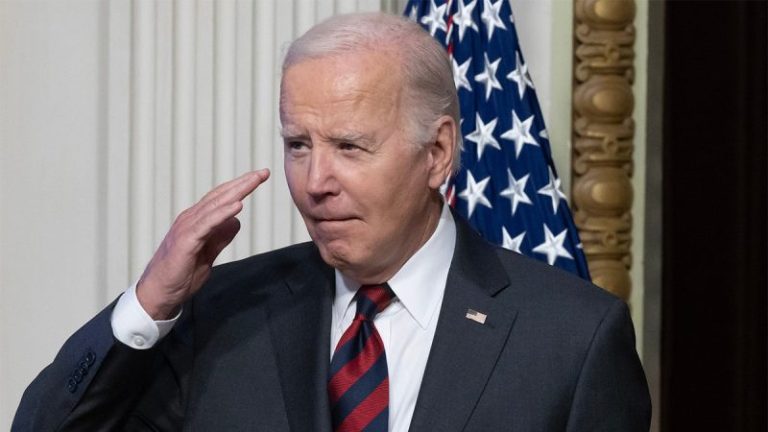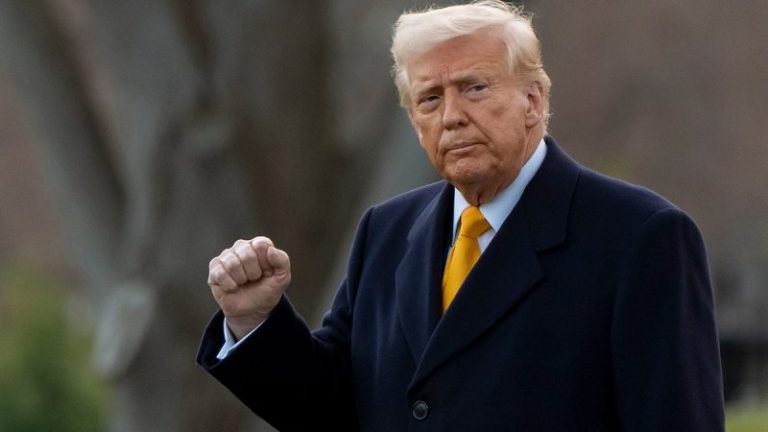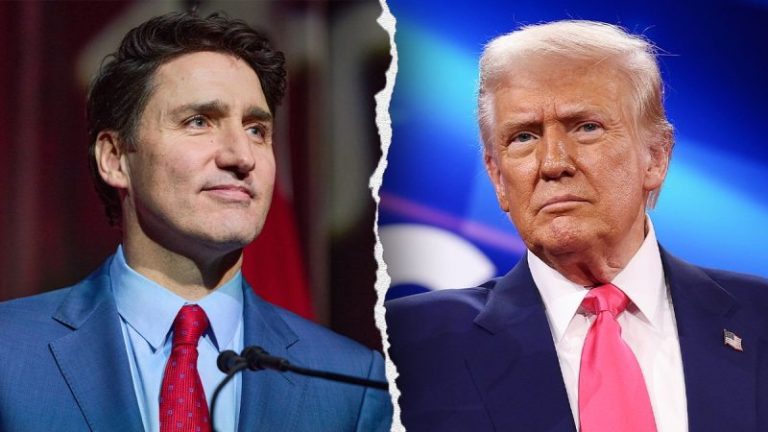The P-3 propellor plane banks sharply, silhouetted against dozens of shimmering lights in the sea against an Argentine sunset. As the camera pans across the scene, it becomes clear: the glaring lights come from dozens of fishing vessels dotting the ocean below.
The footage, shared by the Argentine military in late February, shows the overwhelming scale of a flotilla near a marine boundary which separates the country’s more restrictive exclusive economic zone from less-regulated international waters.
This area, about 200 nautical miles off the coast of southern Argentina, is notorious for illegal and unregulated fishing — often carried out by Chinese vessels, according to the Argentine Navy.
Most of these ships hunt for squid, which are abundant along the Argentine coast and a vital food source in the marine ecosystem.
The Argentine military is now ramping up efforts to combat these fishing operations in a region experts warn is on the brink of environmental collapse.
The military’s footage shows an advanced P-3C “Orion” surveillance plane — designed for anti-submarine and maritime surveillance — approaching the fishing fleet. The aircraft took part in the Argentine military operation in January alongside a smaller C-12 surveillance plane and two corvette warships, according to the Argentine navy.
This surveillance mission was conducted to address ongoing concerns that the fishing vessels may cross into the country’s more restricted EEZ, according to a spokesperson for Defense Minister Luis Petri.
The mission identified a total of 380 fishing vessels just outside Argentina’s EEZ, many of which sailed from Asia to richer waters, the military says.
Since September, the Argentine Navy has acquired multiple planes designed for maritime surveillance, which Petri said will help “control and monitor” the country’s coastline “in light of the enormous challenge we face with the possible intrusion of fishing vessels into our Exclusive Economic Zone.”
Petri described the existential threat earlier this year, arguing that “the (natural) resources of all Argentines are at stake.”
A ‘floating city’ off Argentina’s coast
The cluster of ships, stretching approximately 150 miles from north to south, raised concerns over illicit fishing. At night, many of these fishing vessels turn on bright lights to lure squid to the surface, where they are harvested using a large net. The lights are so strong that they can be seen from space.
Argentina’s Navy has noted a pattern of foreign fishing vessels turning off their tracking systems to avoid detection when illegally fishing inside the exclusive economic zone — an area where Argentina maintains sovereign rights to its natural resources, according to international law.
Historical ship tracking data corroborates the pattern and reveals these abundant waters off Argentina’s coast as a hotspot for lapsed vessel beacons.
Seven of the identified vessels — all sailing under China’s flag — were operating under US sanctions, according to a Treasury Department database.
These ships are linked to Fujian Provincial Pingtan County Ocean Fishing Group Co., Ltd., a Chinese fishing company which was sanctioned by the US in 2022 for its involvement in “serious human rights abuses” and illegal fishing, including operations in the protected waters of the Galapagos Islands and the transport of more than 6,600 shark carcasses, according to a US Treasury Department press release.
The company also received a $19 million subsidy from China’s government as an incentive to develop its deep-water fishing capabilities, according to the statement.
The US Treasury Department press release detailed reports of forced labor, physical abuse, and extreme isolation among crew members. In one case, a Pingtan crew member who tried to leave a vessel after learning of unpaid wages was allegedly denied permission and deprived of food for three days, according to the statement.
It added that China has “actively participated in the formulation of international rules related to fishery subsidies” and has made “contributions to the conservation and sustainable use of fishery resources and the maintenance of a fair and reasonable international maritime order.”
Pingtan Fishing Group stated that it “has endeavored to ensure that its fishing methods are in compliance with international standards and the laws and regulations of the operating waters” in a letter responding to the Treasury Department’s 2022 sanctions.
Satellite imagery obtained from Planet Labs and captured in the area surveilled by the Argentine military offers a glimpse into this fleet.
In one case, a former crewmember on one squid fishing vessel, Ning Tai 52, accused its parent company Zhoushan Ningtai Ocean Fisheries of employing forced labor practices, according to a 2021 Greenpeace report.
In response to the allegation in Greenpeace’s report, Zhoushan Fisheries said they were “perplexed to be receiving this kind of complaint… we assure you that no such thing as forced labor has occurred.”
Illicit fishing has plagued costal Argentina for decades, experts say, with the Argentine Navy saying that Chinese vessels are frequent violators of the exclusive economic zone.
According to the United Nations, illegal, unreported, and unregulated fishing can undermine efforts “to manage fisheries sustainably (and) conserve marine biodiversity.” In some cases, it can lead to the “collapse” of local fisheries, according to the UN.
A wider issue
The problems faced in Argentina are part of a wider pattern of unregulated fishing conducted by Chinese fishing fleets across the globe. Having depleted its own domestic fishing resources, similar Chinese flotillas have been spotted off the coast of Western Africa, in parts of the disputed South China Sea and around South America.
Driving the expansion of China’s global fishing footprint is the ever-growing demand. As China grows richer, its appetite for seafood has also soared. Once a luxury reserved for coastal elites, shrimp, squid, and saltwater fish have become everyday dishes in inland Chinese cities. The country is now the world’s largest seafood consumer and, by one estimate, is expected to drive 40% of the world’s seafood consumption growth by 2030.
Approaching the fleet of fishing vessels at night is akin to watching a sunrise, Schvartzman recounted. Others have described the flotilla as a “floating city” which fills the entire field of view, he recalled, having spent over a decade monitoring overfishing off the coast of Argentina.
“(Only) when you get closer, you find that each light is… a vessel with hundreds of very powerful lights used to fish squid,” Schvartzman says.
By comparison, the Argentine fleet that was authorized to fish inside the EEZ consists of between 70 and 75 ships, according to Darío Sócrate, the executive director of the Argentine Chamber of Squid Jig Owners.
This imbalance harms Argentine fishermen, Sócrate says. He estimates that local fishermen only catch half of what they could have because of the foreign fishing activities.
“You don’t have any place in the world where in a short strip of ocean, you have more than 550 vessels fishing without any regulation,” Schvartzman said. “And the environmental impact is because (of) this.”
“For the species, for the ecosystem, it doesn’t matter if the vessel is one mile farther or closer… the impact is the same.”










